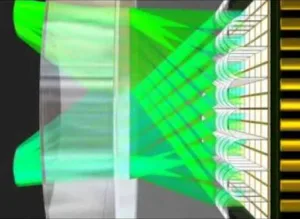Visionsense Corp. (Philadelphia, PA) has developed a high definition 3D camera based on an unconventional technology. The need for an unusual 3D camera is a consequence of the fact that Visionsense products are a family of endoscopes in which the diameter of the device and hence the 3D camera is as small as 4 mm.

As illustrated in the figure below, two apertures allow light from the scene to enter the camera end of the endoscope. The image carrying light then goes through an array of about 1000 micron-sized optical elements. The light exiting each of the optical elements can be thought of as a sub-image containing a slightly different perspective of the scene. This light from each sub-image then goes on to be focused onto a unique section of the single, 3 mm sensor.
It is not unreasonable to describe the input to the sensor as having derived from a thousand tiny “eyes” each looking at the scene from a slightly different direction. Hence, this means of 3D image capture has been referred to by the company as similar to that of the faceted eye of a bee.
The real “magic” in the system is the software developed by Visionsense and used to convert the sub-images received by the sensor into the desired left and right eye images. Resultant images are claimed to be very “clear.” The improved image quality attained by Visionsense’s approach is attributed to bypassing the limits imposed by diffraction on image quality that occurs in miniature cameras based on more conventional technologies.
A video is appended at the end of this article that presents an animation of light traveling through the optics of the Visionsense endoscope. In addition, a second video that can be found here presents imagery captured by the endoscope during an actual surgical procedure. The images can be viewed in 3D by wearing anaglyph glasses. Note, however, that contrary to usual practice, viewers will have to put the red lens on their right eye and the blue one on the left.
A key word search of the US patent office on-line database for IP assigned to Visionsense and containing the terms endoscope and camera technology resulted in identification of two patents (7,990,371 and 8,243,056 ) as well as a patent application (2014-0364693). The claims in the two issued patents relate to the means of calculating the images in the stereo pair from the numerous sub-images. The claims in the patent application deal with the optical implementation of the technology in endoscopic applications.
The HD 3D camera in Visionsense’s VSiii product line includes the capability for dynamic focus and 3X zoom. The products comes with either a rigid scope or a flexible “snake” configuration. The VSiii is controlled by a so-called Camera Control Unit. This system consists of an Intel-powered parallel processing platform. The Camera Control Unit connects to a 24-inch stereoscopic LED monitor. Other 3D display sizes are available to meet the needs of the surgeon. All the display options require the user to wear passive glasses to see the imagery in 3D.
It is unclear if there are any negative image quality tradeoffs associated with the faceted lens approach. Resolution comes to mind. In any case, it will be interesting to see if the approach is “endorsed” by other companies by their adoption of cameras based on variations of the same technology. –Arthur Berman
Visionsense Corp.,Alex Chanin, 1-732-895-7710, [email protected]

